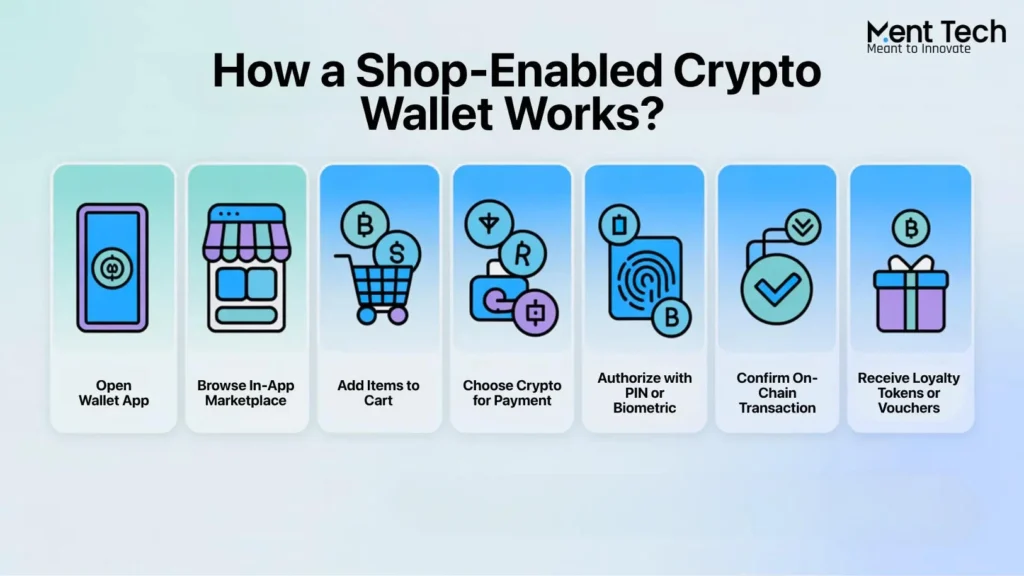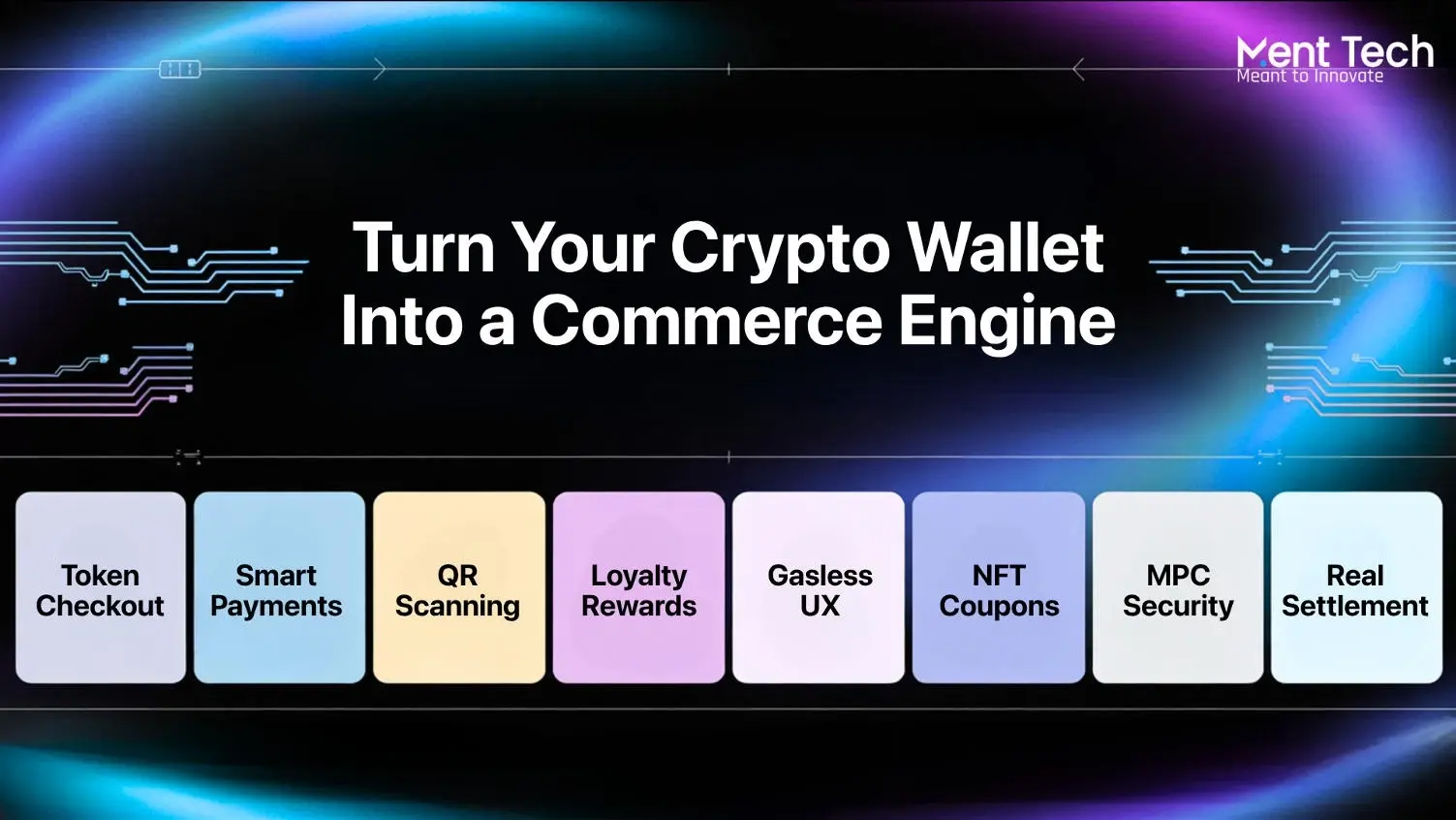Crypto wallets are evolving from simple storage tools into powerful platforms where users can spend, earn, and transact seamlessly in the real world, buying gift cards, booking flights, paying for games, or streaming services without ever leaving the app. What was once just a place to store tokens is now an in-app marketplace offering real-world utility.
With brands like Gucci, Balenciaga, and Shopify merchants accepting crypto, wallets that only store tokens risk being left behind. Modern users want instant transactions in USDT, USDC, or their favorite tokens without conversions or off-ramps.
The global crypto wallet market size was estimated at USD 8.42 billion in 2022 and is expected to reach USD 48.27 billion by 2030, growing at a CAGR of 24.8% from 2023 to 2030. One of the fundamental growth drivers for the market is the widespread adoption of cryptocurrencies as a legitimate asset class.
What Is a Shop-Enabled Crypto Wallet?
A shop-enabled crypto wallet is more than just a place to hold digital assets. It is a multifunctional platform that lets users spend crypto directly inside the wallet. This includes everything from booking travel and buying game credits to ordering food or sending digital gift cards.
Instead of switching apps or converting tokens to fiat, users can browse products, scan QR codes, and check out with crypto all in one interface. These wallets combine blockchain payment rails with real-time commerce to offer a unified experience.
The goal is to make spending as simple as holding. Whether it is using USDT to buy a mobile recharge or using tokens to join a play-to-earn game, everything happens within the wallet itself. It feels more like a superapp than a simple wallet.
This evolution reflects a bigger change in user expectations. People no longer want to manage assets in one place and shop in another. They want crypto wallets to double as everyday tools that fit into their lifestyle.
With the right crypto wallet development approach, builders can deliver a fully functional in-app crypto marketplace. This is not just a feature; it is a new way to think about digital wallets and user engagement.
Why Shopping Makes Crypto Wallets Useful
Crypto wallets are no longer just for storing tokens—they’re becoming everyday spending tools. Adding shopping and checkout features transforms them into real-world utility hubs that keep users engaged and brands connected.
Here’s why shopping makes crypto wallets more valuable:
- Beyond Storage: Wallets are no longer just for holding tokens, they’re evolving into everyday spending tools.
- Easy Utility: Buy gift cards, food, flights, or recharge services directly from your wallet.
- Higher Engagement: Wallets with checkout see up to 4x more user activity than standard ones.
- Faster Payments: Pay instantly with USDT, USDC, or other tokens no fiat conversion needed.
- Gen Z Ready: Over 60% of younger holders prefer wallets with built-in payment options.
- Brand Advantage: Transforms wallets into marketplaces, loyalty hubs, and engagement touchpoints.
- Everyday Relevance: It’s about creating wallets people want to use daily, not just store assets.
How a Shop-Enabled Crypto Wallet Works?
A shop-enabled crypto wallet app lets users browse products, add items to cart, and pay directly with digital assets. It creates a seamless in-app shopping experience while ensuring secure crypto payments and rewarding users with tokens or vouchers.
1. Open Wallet App: Launch the crypto wallet app to access payments, shopping, and rewards in one place, blending financial tools with everyday lifestyle features seamlessly.
2. Browse In-App Marketplace: Explore a crypto wallet with in-app shopping to find products, gift cards, and services, keeping the entire experience inside one platform.
3. Add Items to Cart: Select your favorite products and add them to a secure shopping cart, creating a smooth and familiar ecommerce-like checkout process.
4. Choose Crypto for Payment: Pay with stablecoins or tokens through the crypto payment wallet, enabling instant purchases without fiat conversions or third-party processors.
5. Authorize with PIN or Biometric: Confirm payments using Face ID, fingerprint, or PIN, ensuring every in-app crypto payment remains secure, verified, and user-protected.
6. Confirm On-Chain Transaction: Smart contracts finalize payments transparently on the blockchain, ensuring trust, accuracy, and seamless execution for every transaction.
7. Receive Loyalty Tokens or Vouchers: Earn NFTs, vouchers, or loyalty tokens after shopping, turning your cryptocurrency wallet with shopping into a rewarding daily-use app.

Key Features of an In-App Crypto Shopping Experience
1. Smooth Token Checkout
Users can pay with stablecoins or native tokens directly within the wallet, eliminating the need for conversions or external platforms. Transactions are instant, smooth, and hassle-free.
2. In-Wallet Marketplace
A dedicated shopping tab lets users explore products, services, and exclusive offers without leaving the app. Wallets now act as full-featured marketplaces with real-world utility.
3. Scan-to-Pay QR Codes
Merchants can accept crypto payments via simple QR code scans, and users complete purchases in a single tap. This makes in-person transactions quick and convenient.
4. Gasless Transactions
Relayer systems or smart contract paymasters enable users to pay without worrying about gas fees. Wallets handle the backend so payments remain seamless and cost-effective.
5. Multi-Chain Support
Users can spend across multiple blockchains and tokens, enabling flexible transactions in their preferred assets, powered by innovations from crypto exchange development services.
6. Loyalty and Reward Programs
Every purchase can earn users NFT vouchers or loyalty tokens, promoting engagement and repeat usage. Wallets are becoming platforms that reward users while driving merchant loyalty.
Smart Ways to Keep Your Crypto Wallet Safe
Security is critical in crypto wallets, especially those handling payments and in-app shopping. Users expect complete protection, and any vulnerability can lead to financial loss or loss of trust.
Key management should use advanced techniques like multi-party computation or multisignature logic to prevent single-key access and ensure high-value transactions require multiple approvals. Smart contracts must undergo full audits and verification to avoid vulnerabilities during real-world use.
Biometric authentication and PIN access add user-level protection, confirming identity through Face ID, fingerprints, or secure passwords before transactions. Real-time monitoring of transactions, gas usage, and volume spikes can trigger smart contract circuit breakers to prevent risks. For greater adoption, a crypto marketing agency can help build user trust by highlighting these robust security measures.
Compliance is essential: zero-knowledge KYC and sanction checks protect privacy while meeting global regulations. All user data, including transaction history and payment metadata, should be fully encrypted to ensure end-to-end security.

Steps to Build a Crypto Wallet With In-App Shopping
Step 1: Define Product Scope and Target Use Cases
Start by identifying your user segment and key use cases. Decide if the wallet will focus on gaming, travel, gift cards, or utilities. Choose the tokens you want to support, such as USDT, USDC, or native tokens. Map the expected user flow, including shopping, checkout, and reward redemption.
Step 2: Design the Wallet Architecture
Select the right wallet structure, such as MPC or smart contract-based architecture. Define how paymasters will handle gas fees and how cross-chain tokens will be routed. Plan the backend logic for checkout, vouchers, merchant payouts, and loyalty systems.
Step 3: Build Smart Contract Modules
Develop secure and modular smart contracts that handle marketplace transactions, token routing, voucher logic, and reward distribution. Include pricing feeds via oracle integration and token support for stablecoins and native assets.
Step 4: Develop Front-End and Mobile Wallet UI
Create a responsive wallet interface using technologies like React Native or Flutter. Include screens for product browsing, cart management, payment confirmation, and loyalty tracking. Keep the interface simple while supporting QR payments, biometric security, and one-click checkout.
Step 5: Integrate SDKs and Third-Party Services
Add modules for scan-to-pay, price feed oracles, and zkKYC verification. Set up relayers and bridges to handle gasless and cross-chain execution. Connect the wallet to merchant storefronts or DApps using prebuilt SDKs.
Step 6: Conduct Testing and Security Audits
Run unit tests, integration tests, and real-time stress tests to ensure performance. Submit smart contracts for third-party audit and formal verification. Validate transaction safety, key management, and circuit breaker triggers.
Step 7: Launch With Pilot Merchants and Iterate
Onboard a small group of merchants or marketplaces. Monitor user behavior, token performance, and shopping activity. For wallets supporting new assets, align with crypto exchange listing for new token strategies to drive adoption. Use this feedback to refine the shopping flow, improve UX, and scale merchant partnerships.
How Much Does It Cost to Build a Crypto Wallet With Shopping Features?
| Type of Wallet | Estimated Cost Range (USD) | Ideal For |
| MVP Wallet (Basic Shopping & Payments) | $40,000 – $80,000 | Startups looking to launch quickly with basic shopping, 1–2 chain support, a small in-app marketplace, and simple relayer integration. |
| Full-Featured Wallet (Multi-Chain & Commerce) | $100,000 – $250,000 | Enterprises needing multi-chain compatibility, stablecoin checkout, loyalty/reward tokens, merchant onboarding, compliance modules, smart contract audits, and advanced analytics. |
Working with an experienced cryptocurrency wallet development company can help you streamline this process. By using proven frameworks, audited modules, and pre-built SDKs, you reduce risk and shorten time to market.
Final Thoughts
Crypto wallets are shifting from simple storage to powerful platforms built for real-world transactions, loyalty, and merchant interaction. To succeed, your wallet must offer seamless shopping, secure payments, and a scalable architecture that users trust.
Ment Tech Labs, a leading crypto wallet development company, builds commerce-ready crypto wallets designed for sectors like gaming, travel, and digital rewards. From MPC security and smart contracts to cross-chain integrations and in-app marketplaces, we handle everything under one roof.
Launch a shop-enabled crypto wallet that users love. Partner with MentTech Labs today to build a future-ready wallet that delivers real-world utility and long-term value.
Frequently Asked Questions
1. What is a shop-enabled crypto wallet?
A shop-enabled crypto wallet allows users to browse and purchase products or services directly within the wallet. It combines payment, loyalty, and marketplace features into a single experience without requiring the conversion of crypto to fiat.
2. How does in-app shopping work inside a crypto wallet?
In-app shopping allows users to pick items, confirm purchases, and pay with tokens like USDT or USDC. Smart contracts handle pricing and settlement, while crypto liquidity solutions ensure smooth swaps and merchant payouts.
3. Why should you add shopping features to a crypto wallet?
Adding shopping features turns a crypto wallet into a daily utility tool. It improves engagement, creates new revenue streams through merchant integrations, and increases real-world use of digital assets.
4. What types of payments can users make inside a crypto wallet?
Users can pay for digital goods, mobile recharges, gaming credits, travel bookings, and gift cards. Payments are settled in stablecoins or native tokens, with options for gasless transactions and scan-to-pay functionality.
5. How secure is a crypto wallet with marketplace features?
Security is handled through multi-party computation, biometric access, and verified smart contracts. Additional layers, like real-time monitoring and circuit breakers, ensure the system responds instantly to any abnormal activity.
6. Can a crypto wallet support tokens from multiple blockchains?
Yes. Commerce-enabled wallets often integrate cross-chain bridges that allow users to spend tokens from multiple blockchains in a single unified marketplace.


